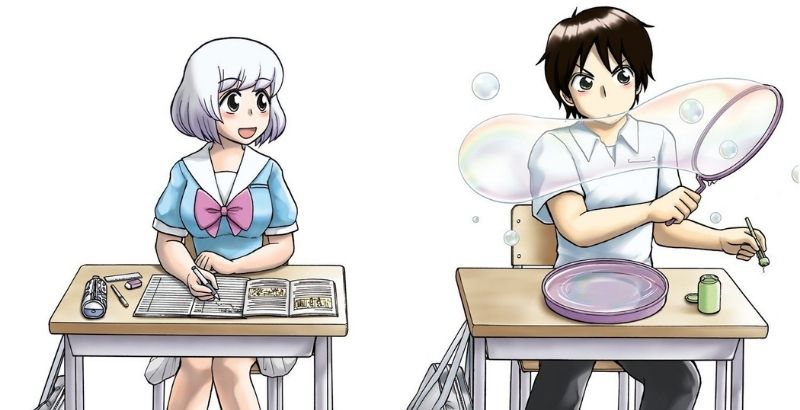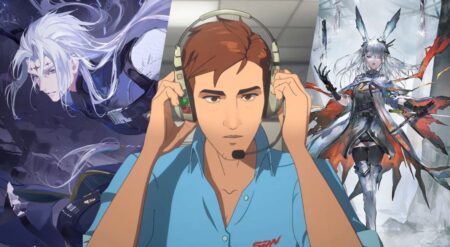
I found myself looking for more wholesome manga picks a while ago and there was one series that stayed on the brain for a while until I could properly wax reread it and wax poetically about it. My Neighbor Seki, originally published in Japan as Tonari no Seki-kun is a comedic slice of life styled series by Takuma Morishige (brother to Akiko Higashimura–mangaka of Princess Jellyfish, Tokyo Tarareba Girls, Blank Canvas, and others)This manga follows a school aged boy named Toshinari Seki who takes goofing off in school to a whole new level. Seemingly a slacker by trade, he brings something new and cool to his desk every day and it is more elaborate and obscure the more time passes.
Lost in his own little world of recreating famous pieces of art and digging for the biggest archaeological finds of the century means that he’s caught the attention of his classmate Rumi Yokoi, his neighbor at the back of their homeroom who unfortunately is fascinated and distracted by his fun. This series captures Rumi and Seki’s adventures in staving off boredom and the importance of being able to have a childhood. First released in 2010, My Neighbor Seki was nominated in the 5th Manga Taisho Awards back in 2012, inspired both an anime adaptation and even a live-action show. This amazing 10-volume series from Kodansha‘s Vertical imprint teaches readers a few lessons. The first is to cherish our imagination, the second is to not look down on spontaneity, and finally to find friendship where you’d least expect it.
Some of the charm of this series through Yokoi’s eyes is the level of absurdness that comes with each chapter of reading. Each chapter, affectionately titled Period, as in a class period finds the two students locked in this cycle of finding something new in class and the hilarity that comes with it. Yokoi sees her classmate furiously creating a professional-styled logo of his first name one day in class—and then he goes on to place it nearly everywhere like a cool store brand. Yokoi reminiscences on being younger with friends and practicing their penmanship and creating their own cute logos and signage in their notebooks. Another time when our titular character pulls out a miniature Christmas tree on his desk to decorate, his neighbor in class is touched by the Christmas spirit and happily ponders on how to make the season at school more festive.
Yokoi comes away with learning a thing or two ever so often: she may not know how to play chess but understands it to be a widely played game around the world. She may not know the rules per say, but she knows for sure that you don’t make a giant chess piece out of one color and go on to smash and demolish the now tiny, regular-sized chess pieces of the opposing color! She does however know more of the rules of playing with one hundred poet cards via Karuta, which is a traditional Japanese card game that I recognized this time because of reading Chihayafuru.
Readers will pick up that just perhaps our boy doesn’t know or care to stand by the full rules of said game or activity but he’s having fun and he stretches the boundaries to have his fill of killing time and playing to his imagination. This is one of the first lessons we readers can glean from reading My Neighbor Seki,–using our imagination is a muscle we never forget how to use but may need some reminders from time to time on flexing!
I love that Seki’s antics are not limited just to the classroom–his adventures that include Yokoi also take place in other classes and even outside the building: some outdoor fun happens during P.E. classes and special days like their school field day where team-building exercises and activities are an all-day occurrence. Seiki is bound to find ways to enjoy himself anywhere and everywhere and thus the fun continues! Looking at the covers of each volume just really puts in focus the variety of activities of objects that are fair game each day these two met: from hand puppets to a miniature bamboo garden to a volcano that looks straight out of a science fair.
My favorite characters that kept making a recurrence throughout the series are a set of Transformer-rescue robots, a family of them that belong to Seki. The family is made up of a mother, father and child mini robot toys that make appearances across the different volumes that Seiki often brings to school where they hang out in his desk or his locker. They even go on a few off-campus trips! They go to a park and have their own kites and picnics and even the child robot runs away from home—as Yokoi interprets the situation. The way she gets emotionally attached to these inanimate objects is hilarious but endearing and also characters I found myself always happy to see in each volume. The spontaneous energy that comes from the scenes with the robot family is one of the best illustrative ways to show how Yokoi is opening herself.
There is nothing wrong in paying attention at school or during school events. Yokoi shouldn’t be shamed for wanting good grades or wanting to be courteous to her teachers or fellow students. Yet she finds after being entangled with Seki so much after a while that she should take it easy sometimes. She should take a breather. She starts to look for the fun and beauty in little things: around the school, commuting home and around the neighborhood, and the like. Over the 10 volumes of the manga, she starts to look forward to what new thing her desk neighbor brings to homeroom and what cool activity she can find Seki entangled out of class.

Through Seki, she does meet a few new faces and is appreciative of much including her friendships, her family and the experiences she’s able to have including certain school events and trips. This is the second lesson we readers can pick up from reading My Neighbor Seki, allowing ourselves to be spontaneous from time to time is only beneficial to us! It helps keep life from being stale, this is a lesson we often need to be reminded of when adulthood arrives.
There’s some character development here too: Yokoi goes from being very judgemental of Seki. She was once so firmly stuck on her ideal that he was pure slack and troublemaker with a clear disrespect of their teachers’ efforts and the institution of learning. Yet as time passes, this mostly goes out the window as throughout several escapades, she tries to warn him, especially with the more elaborate hobbies and items that he brings to this table, er school desk. The second layer of storytelling is the funny way their relationship is misconstrued and perceived by others: there’s a growing number of students, especially Yokoi’s friend circle who start thinking that the Yokoi has a crush on Seki or that they’re romantically involved. The ante is upped when Yoki meets a member of his family and their lives are further entangled.
Yokoi goes from being an outsider, an observer to a participant in some of his games, being buyer of some of his crafts and savior to of the creatures and inventions he makes. She goes on to save Seki’s robot family from certain doom outdoors, stars in a short film centering on the romance of a kajiu, and even considers future careers from all the manga, blueprints, and art installations that her homeroom desk partner brings along. This manga makes me think back and reminisce of all the fun that I had growing up from the early years when I was just learning the alphabet and all the basic foundations in education to my later teen years in high school.
Friends made up the best parts of the school, at every age. The group of friends that I had when we all first discovered manga and watched Toonami’s block of animation back in the day as a middle schooler still stays in my heart as do my three cousins: Mary, Darius, and Kayla, my first friends that I attended Kindergarten with. My best friends in high school that I made short films within the Media and Film club are just important as they also filled my days with great memories that I’ll remember forever.

Students are in school for so much of their lives–so many hours a day and for so many years. Being able to be social, have fun, and make friends should be a part of every childhood. And this is perhaps the most important lesson, we readers can obtain by reading My Neighbor Seki: we can find friendships when and where we may least expect it. Never immediately count out someone because of they may be different from you, you just may find yourself missing out on the best fun you’ve had in a long time.
After rereading this series, I am happy to be reminded that an anime adaptation does exist, thanks to the streaming app, Crunchyroll. Appropriately titled: Tonari no Seki-kun: The Master of Killing Time, it is a twenty-one-episode series with short episodes, mostly eight minutes in total. The anime’s intro cleverly shows Seki with an animation light-box on his desk among other activities as he creates a basic flip-book of both him and Yokoi. The intro is literally breaking the fourth wall in such a fast-paced and pretty fun way that feels true to the feel of the original work.
My Neighbor Seki is certainly a comfort read, manga-wise for those who love the comedy, school life, and slice of life genres. Rereading the series has led me to appreciate the lessons it imparts to readers: on flexing your imagination, letting spontaneity into your life, and most importantly, being able to find a friend anywhere, in places you’d least expect it. While the main series may be complete for now, back in 2020, the mangaka released what looks like a sequel. Titled Tonari no Seki-kun Junior, my first impressions are of Yokoi being a parent chasing around a toddler with very Seki-like behavior. While not translated and published for English as of now, I can only speculate on the hi-jinks and Yokoi and Seki’s relationship and want to reread the original series again. (I won’t mind a boxed set of the manga, Kodansha — Just saying)
The manga series can be found both digitally and physically where comics and manga can be found.







